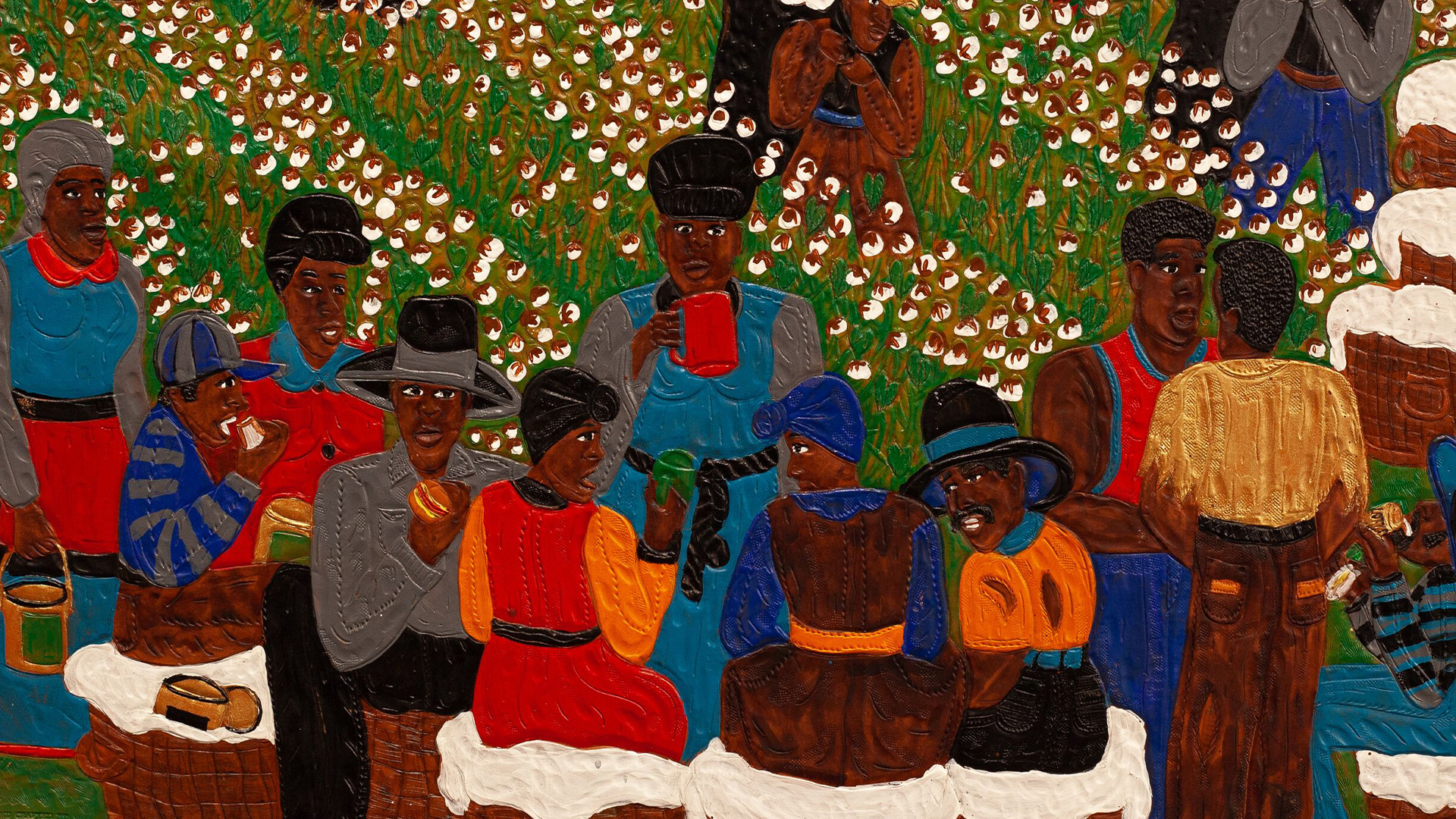
Winfred Rembert
The Estate of Winfred Rembert

Winfred Rembert (1945 – 2021) was born in Americus, Georgia and grew up in nearby Cuthbert, a rural railroad town located in the southwest region of the state, once at the center of the Deep South’s plantation economy. Living in Cuthbert during the era of Jim Crow, Rembert was exposed at a young age to the exploitative practices of the sharecropping system. Spending much of his childhood alongside family members working in the fields, Rembert received a limited education. Despite the infrequency of his attendance, a dedicated teacher by the name of Miss Prather recognized Rembert’s artistic talent and encouraged him to express his creativity through drawing.
As a teenager, Rembert was deeply influenced by the burgeoning Civil Rights Movement in Americus, where his active participation led to confrontations with law enforcement. In 1965, while attending a peaceful protest which was attacked by white antagonists, he fled from the assailants in a stolen car and was subsequently arrested for the theft. In 1967, still incarcerated while awaiting charges, Rembert escaped from jail. Following his ensuing capture by an angry white mob, Rembert survived a near-lynching. For the next seven years of his life, he was transferred to multiple penitentiaries within the Georgia prison system, enduring taxing physical labor while working on various chain gangs—a harrowing experience that would later prove central to the narrative of his extraordinary art.
Rembert learned how to tool and craft leather from a fellow prisoner—the technique he would later use to share his story with the world. Following his release from prison in 1974, Rembert married Patsy Gammage; the couple eventually settled in New Haven, Connecticut, and raised a family there. At the age of fifty-one, with his wife’s encouragement, Rembert began a full-time artistic practice. Combining his mastery of leather working with his skilled draftsmanship, he built a unique body of autobiographical paintings and continued to make art for nearly twenty-five years, before his death on March 31, 2021, at the age of 75.
Over the course of his career, Rembert embraced a variety of styles and pictorial strategies. His works range from purely illustrative to extremely complex compositions that verge on abstraction. In many of the early paintings, the materiality of Rembert’s media is immediately apparent. In such works, he rendered his figures in muted tones to compliment the natural color of the leather backgrounds. In other works, bright-colored pigments cover the entire surface of densely packed compositions. Over time, Rembert’s compositions accrued as a chronicle of his life, through pictorial landscapes of cotton fields and rhythmic compositions of field workers, freedom marches, church services, juke joints, and chain gangs in the Jim Crow south. In its narrative and formal qualities, Rembert’s work, with its corporeal texture, intense color, powerful patterns, and depictions of both hardship and pleasure, takes its place among the oeuvres of the most influential American figurative masters.
The York Square Cinema in New Haven launched a solo exhibition of Rembert’s leather paintings in 1998. Exhibitions followed at the Yale University Art Gallery and in New York, Atlanta, Los Angeles, among other locales and, in 2012, the artist received his first major solo museum presentation: ‘Amazing Grace’ debuted at the Hudson River Museum in Yonkers, New York, before travelling to four additional venues. This survey included more than fifty works and incorporated historical photographs of Georgia, as well as gospel music recorded and performed in the Museum’s galleries by Rembert. ‘Amazing Grace’ also showcased the feature-length documentary ‘All Me: The Life and Times of Winfred Rembert’ (2011), produced and directed by Vivian Ducat. When reminiscing on the title of the exhibition, the artist stated, ‘Amazing Grace is one of the songs I remember that was sung in the fields. I just loved to listen to the singing. Singing was the only thing about the fields that I loved.’
Winfred Rembert’s work is represented in the permanent collections of Blanton Museum of Art, Austin, TX; Cleveland Museum of Art, Cleveland, OH; Crystal Bridges Museum of American Art, Bentonville, AR; Flint Institute of the Arts, Flint, MI; Florence Griswold Museum, Old Lyme, CT; Georgia Museum of Art, University of Georgia, Athens, GA; Glenstone, Potomac, MD; High Museum of Art, Atlanta, GA; Hood Museum of Art, Dartmouth College, Hanover, NH; Legacy Museum, Equal Justice Initiative, Montgomery, AL; Hudson River Museum, Yonkers, NY; Lucas Museum of Narrative Art, Los Angeles, CA; Milwaukee Art Museum, Milwaukee, WI; Minneapolis Institute of Art, Minneapolis, MN; Muskegon Museum of Art, Youngstown, OH; National Gallery of Art, Washington, D.C.; Richard M. Ross Museum of Art, Wesleyan University, Delaware, OH; Speed Art Museum, Louisville, KY; Wadsworth Atheneum Museum of Art, Hartford, CT; and Yale University Art Gallery, New Haven, CT. Rembert’s work was highlighted in major exhibitions at the Montgomery Museum of Fine Arts, Montgomery, AL in 2013; the Flint Institute of the Arts, Flint, MI in 2013; the Citadelle Art Foundation, Canadian, Texas in 2012; the Hudson River Museum, Yonkers, NY in 2012; the Greenville County Museum of Art, Greenville, SC in 2012; and the Yale University Art Gallery, New Haven, CT in 2000.
The artist’s memoir ‘Chasing Me to My Grave: An Artist’s Memoir of the Jim Crow South’ (with Erin I. Kelly, Bloomsbury, 2021) was awarded a posthumous Pulitzer Prize in 2022.
Biography
Solo Exhibitions
Selected Group Exhibitions
Awards and Grants
Bibliography
Monographs
Artist's Books, Writings
Press
Audiovisuals
Exhibitions
Events
1 / 2
News
1 / 2


















